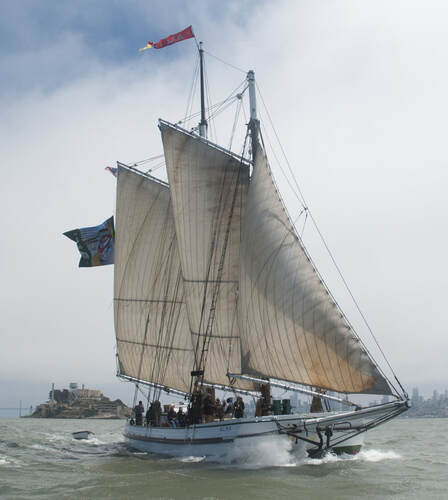The Alma Among America’s Historic Tall Ships
By James Donahue
She isn’t a large vessel. But the 80-foot scow schooner Alma is a restored ship from the nation’s past. It is described as a wide, flat sailing boat with gaff-rigged sails. They were the kind of vessels used near the turn of the century to carry the kind of heavy cargo that trucks carry today, from town to town along the coastal and river fronts of the country.
German shipbuilder Fred Siemer built the Alma on the shores of San Francisco Bay in 1891. He named the vessel after his daughter-in-law. A second scow schooner, also launched on the bay, was named for his daughter, Adelia.
Marine historians say the Alma was unique because its bottom planking was laid side-to-side instead of fore-and-aft. That kind of construction was known as "log built" and required very thick planking. The design traded speed for economy and strength.
During its years of service, the Alma rarely, if ever, left the immediate San Francisco Bay area. She mostly carried hay and lumber under sail. After the owners removed the masts in 1918, the vessel was used as a tow barge, hauling salt. Frank Resech purchased the Alma in 1926 and installed a gasoline engine in it. He used it to dredge oyster shells in a large wooden bin installed on deck. The shells were ground up and used in chicken feed.
The Alma continued to operate as an oyster shell dredge until 1957 when its owners retired her. But the ship had been so well constructed it was still in seaworthy condition. It was just too small for a profitable operation. Marine historians were aware of the ship’s history and were actively involved in leading a restoration effort.
The State of California purchased Alma in 1959 and the restoration work began in 1964. By 1978 the ship was turned over to the National Park Service and designated a National Historic Landmark by 1988. The Alma now is part of the San Francisco Maritime National Historical Park’s fleet of historic vessels. They can be visited at the Hyde Street Pier.
By James Donahue
She isn’t a large vessel. But the 80-foot scow schooner Alma is a restored ship from the nation’s past. It is described as a wide, flat sailing boat with gaff-rigged sails. They were the kind of vessels used near the turn of the century to carry the kind of heavy cargo that trucks carry today, from town to town along the coastal and river fronts of the country.
German shipbuilder Fred Siemer built the Alma on the shores of San Francisco Bay in 1891. He named the vessel after his daughter-in-law. A second scow schooner, also launched on the bay, was named for his daughter, Adelia.
Marine historians say the Alma was unique because its bottom planking was laid side-to-side instead of fore-and-aft. That kind of construction was known as "log built" and required very thick planking. The design traded speed for economy and strength.
During its years of service, the Alma rarely, if ever, left the immediate San Francisco Bay area. She mostly carried hay and lumber under sail. After the owners removed the masts in 1918, the vessel was used as a tow barge, hauling salt. Frank Resech purchased the Alma in 1926 and installed a gasoline engine in it. He used it to dredge oyster shells in a large wooden bin installed on deck. The shells were ground up and used in chicken feed.
The Alma continued to operate as an oyster shell dredge until 1957 when its owners retired her. But the ship had been so well constructed it was still in seaworthy condition. It was just too small for a profitable operation. Marine historians were aware of the ship’s history and were actively involved in leading a restoration effort.
The State of California purchased Alma in 1959 and the restoration work began in 1964. By 1978 the ship was turned over to the National Park Service and designated a National Historic Landmark by 1988. The Alma now is part of the San Francisco Maritime National Historical Park’s fleet of historic vessels. They can be visited at the Hyde Street Pier.
